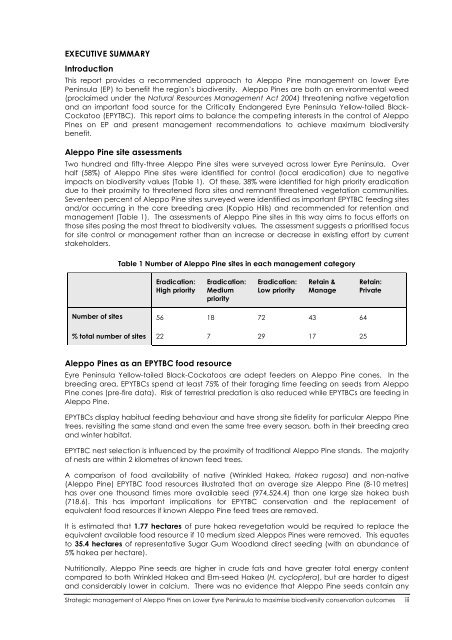Strategic management of Aleppo Pines on Lower Eyre
Strategic management of Aleppo Pines on Lower Eyre
Strategic management of Aleppo Pines on Lower Eyre
Create successful ePaper yourself
Turn your PDF publications into a flip-book with our unique Google optimized e-Paper software.
EXECUTIVE SUMMARY<br />
Introducti<strong>on</strong><br />
This report provides a recommended approach to <str<strong>on</strong>g>Aleppo</str<strong>on</strong>g> Pine <str<strong>on</strong>g>management</str<strong>on</strong>g> <strong>on</strong> lower <strong>Eyre</strong><br />
Peninsula (EP) to benefit the regi<strong>on</strong>’s biodiversity. <str<strong>on</strong>g>Aleppo</str<strong>on</strong>g> <str<strong>on</strong>g>Pines</str<strong>on</strong>g> are both an envir<strong>on</strong>mental weed<br />
(proclaimed under the Natural Resources Management Act 2004) threatening native vegetati<strong>on</strong><br />
and an important food source for the Critically Endangered <strong>Eyre</strong> Peninsula Yellow-tailed Black-<br />
Cockatoo (EPYTBC). This report aims to balance the competing interests in the c<strong>on</strong>trol <str<strong>on</strong>g>of</str<strong>on</strong>g> <str<strong>on</strong>g>Aleppo</str<strong>on</strong>g><br />
<str<strong>on</strong>g>Pines</str<strong>on</strong>g> <strong>on</strong> EP and present <str<strong>on</strong>g>management</str<strong>on</strong>g> recommendati<strong>on</strong>s to achieve maximum biodiversity<br />
benefit.<br />
<str<strong>on</strong>g>Aleppo</str<strong>on</strong>g> Pine site assessments<br />
Two hundred and fifty-three <str<strong>on</strong>g>Aleppo</str<strong>on</strong>g> Pine sites were surveyed across lower <strong>Eyre</strong> Peninsula. Over<br />
half (58%) <str<strong>on</strong>g>of</str<strong>on</strong>g> <str<strong>on</strong>g>Aleppo</str<strong>on</strong>g> Pine sites were identified for c<strong>on</strong>trol (local eradicati<strong>on</strong>) due to negative<br />
impacts <strong>on</strong> biodiversity values (Table 1). Of these, 38% were identified for high priority eradicati<strong>on</strong><br />
due to their proximity to threatened flora sites and remnant threatened vegetati<strong>on</strong> communities.<br />
Seventeen percent <str<strong>on</strong>g>of</str<strong>on</strong>g> <str<strong>on</strong>g>Aleppo</str<strong>on</strong>g> Pine sites surveyed were identified as important EPYTBC feeding sites<br />
and/or occurring in the core breeding area (Koppio Hills) and recommended for retenti<strong>on</strong> and<br />
<str<strong>on</strong>g>management</str<strong>on</strong>g> (Table 1). The assessments <str<strong>on</strong>g>of</str<strong>on</strong>g> <str<strong>on</strong>g>Aleppo</str<strong>on</strong>g> Pine sites in this way aims to focus efforts <strong>on</strong><br />
those sites posing the most threat to biodiversity values. The assessment suggests a prioritised focus<br />
for site c<strong>on</strong>trol or <str<strong>on</strong>g>management</str<strong>on</strong>g> rather than an increase or decrease in existing effort by current<br />
stakeholders.<br />
Number <str<strong>on</strong>g>of</str<strong>on</strong>g> sites<br />
% total number <str<strong>on</strong>g>of</str<strong>on</strong>g> sites<br />
Table 1 Number <str<strong>on</strong>g>of</str<strong>on</strong>g> <str<strong>on</strong>g>Aleppo</str<strong>on</strong>g> Pine sites in each <str<strong>on</strong>g>management</str<strong>on</strong>g> category<br />
Eradicati<strong>on</strong>:<br />
High priority<br />
Eradicati<strong>on</strong>:<br />
Medium<br />
priority<br />
Eradicati<strong>on</strong>:<br />
Low priority<br />
Retain &<br />
Manage<br />
56 18 72 43 64<br />
22 7 29 17 25<br />
Retain:<br />
Private<br />
<str<strong>on</strong>g>Aleppo</str<strong>on</strong>g> <str<strong>on</strong>g>Pines</str<strong>on</strong>g> as an EPYTBC food resource<br />
<strong>Eyre</strong> Peninsula Yellow-tailed Black-Cockatoos are adept feeders <strong>on</strong> <str<strong>on</strong>g>Aleppo</str<strong>on</strong>g> Pine c<strong>on</strong>es. In the<br />
breeding area, EPYTBCs spend at least 75% <str<strong>on</strong>g>of</str<strong>on</strong>g> their foraging time feeding <strong>on</strong> seeds from <str<strong>on</strong>g>Aleppo</str<strong>on</strong>g><br />
Pine c<strong>on</strong>es (pre-fire data). Risk <str<strong>on</strong>g>of</str<strong>on</strong>g> terrestrial predati<strong>on</strong> is also reduced while EPYTBCs are feeding in<br />
<str<strong>on</strong>g>Aleppo</str<strong>on</strong>g> Pine.<br />
EPYTBCs display habitual feeding behaviour and have str<strong>on</strong>g site fidelity for particular <str<strong>on</strong>g>Aleppo</str<strong>on</strong>g> Pine<br />
trees, revisiting the same stand and even the same tree every seas<strong>on</strong>, both in their breeding area<br />
and winter habitat.<br />
EPYTBC nest selecti<strong>on</strong> is influenced by the proximity <str<strong>on</strong>g>of</str<strong>on</strong>g> traditi<strong>on</strong>al <str<strong>on</strong>g>Aleppo</str<strong>on</strong>g> Pine stands. The majority<br />
<str<strong>on</strong>g>of</str<strong>on</strong>g> nests are within 2 kilometres <str<strong>on</strong>g>of</str<strong>on</strong>g> known feed trees.<br />
A comparis<strong>on</strong> <str<strong>on</strong>g>of</str<strong>on</strong>g> food availability <str<strong>on</strong>g>of</str<strong>on</strong>g> native (Wrinkled Hakea, Hakea rugosa) and n<strong>on</strong>-native<br />
(<str<strong>on</strong>g>Aleppo</str<strong>on</strong>g> Pine) EPYTBC food resources illustrated that an average size <str<strong>on</strong>g>Aleppo</str<strong>on</strong>g> Pine (8-10 metres)<br />
has over <strong>on</strong>e thousand times more available seed (974,524.4) than <strong>on</strong>e large size hakea bush<br />
(718.6). This has important implicati<strong>on</strong>s for EPYTBC c<strong>on</strong>servati<strong>on</strong> and the replacement <str<strong>on</strong>g>of</str<strong>on</strong>g><br />
equivalent food resources if known <str<strong>on</strong>g>Aleppo</str<strong>on</strong>g> Pine feed trees are removed.<br />
It is estimated that 1.77 hectares <str<strong>on</strong>g>of</str<strong>on</strong>g> pure hakea revegetati<strong>on</strong> would be required to replace the<br />
equivalent available food resource if 10 medium sized <str<strong>on</strong>g>Aleppo</str<strong>on</strong>g>s <str<strong>on</strong>g>Pines</str<strong>on</strong>g> were removed. This equates<br />
to 35.4 hectares <str<strong>on</strong>g>of</str<strong>on</strong>g> representative Sugar Gum Woodland direct seeding (with an abundance <str<strong>on</strong>g>of</str<strong>on</strong>g><br />
5% hakea per hectare).<br />
Nutriti<strong>on</strong>ally, <str<strong>on</strong>g>Aleppo</str<strong>on</strong>g> Pine seeds are higher in crude fats and have greater total energy c<strong>on</strong>tent<br />
compared to both Wrinkled Hakea and Elm-seed Hakea (H. cycloptera), but are harder to digest<br />
and c<strong>on</strong>siderably lower in calcium. There was no evidence that <str<strong>on</strong>g>Aleppo</str<strong>on</strong>g> Pine seeds c<strong>on</strong>tain any<br />
<str<strong>on</strong>g>Strategic</str<strong>on</strong>g> <str<strong>on</strong>g>management</str<strong>on</strong>g> <str<strong>on</strong>g>of</str<strong>on</strong>g> <str<strong>on</strong>g>Aleppo</str<strong>on</strong>g> <str<strong>on</strong>g>Pines</str<strong>on</strong>g> <strong>on</strong> <strong>Lower</strong> <strong>Eyre</strong> Peninsula to maximise biodiversity c<strong>on</strong>servati<strong>on</strong> outcomes iii

















